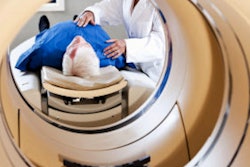
FDG-PET/CT scans may be preferred over invasive biopsies for detecting bone marrow cancer in lymphoma patients, according to research published February 12 in Cureus.
Researchers led by pathologist Dr. Hiba Asif of the Shaukat Khanum Memorial Cancer Hospital and Research Center in Lahore, Pakistan, compared the two approaches in a group of patients with large B-cell lymphoma (DLBCL). F-18 FDG-PET/CT scans were more accurate and could save patients from pain and other adverse outcomes due to invasive biopsies, they wrote.
"PET/CT scan is an effective imaging modality in the detection of bone marrow involvement in DLBCL patients, and its relative advantages over bone marrow biopsy might conclude this to be a preferred technique," the group wrote.
DLBCL is the most common type of non-Hodgkin's lymphoma among adults and is predominant in older individuals. Mature B-cell tumors can occur anywhere in the body, including bone marrow.
Bone marrow biopsy is still the gold standard method used in lymphoma staging worldwide, yet the procedures are invasive and painful and may not yield adequate material for pathologists to interpret, according to the authors. In recent years, PET/CT has become an effective method in the diagnosis and staging of lymphoma, but its diagnostic and prognostic value to determine bone marrow involvement remains controversial, they added.
 F-18 FDG-PET/CT showing FDG-avid lesion with osseous involvement in a patient with diffuse large B-cell lymphoma. Image courtesy of Cureus through CC BY 4.0.
F-18 FDG-PET/CT showing FDG-avid lesion with osseous involvement in a patient with diffuse large B-cell lymphoma. Image courtesy of Cureus through CC BY 4.0.To elucidate the issue, the group compared the methods in retrospective data from 146 patients ages 18 to 80 of either gender with a confirmed diagnosis of DLBCL on tissue biopsy. All patients had bone biopsies and underwent whole-body F-18 FDG-PET/CT scans (Gemini TF 16, Philips) from the base of the skull to the mid-thigh.
According to the analysis, 47 (32.19%) cases had bone marrow involvement identified on bone marrow biopsies and 50 (34.2%) cases had bone marrow involvement seen on PET/CT scans. There were six false positives on PET/CT but not on biopsy and three false negatives on biopsy but not on PET/CT. The overall diagnostic accuracy of PET/CT was 93.84%.
"It is suggested to choose this non-invasive technique because the presence of a disease in extramedullary space can also be detected and the evaluation of bone marrow in the whole body can be performed," the researchers wrote.
Ultimately, the results support similar findings in other studies that diagnostic F-18 FDG-PET/CT is as effective or better than bone biopsies in patients with DLBCL, the authors wrote. Nonetheless, more research is warranted, given that this was a single-center study in adults only and results may not be reflective of a broader population, they added.
"More studies need to be done to make PET/CT scan a standard diagnostic modality for the accurate staging of DLBCL patients," the group concluded.





















